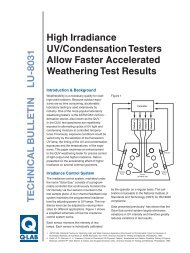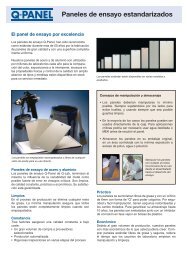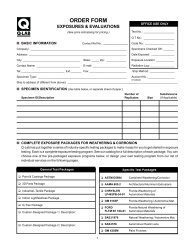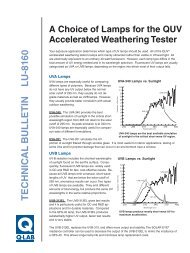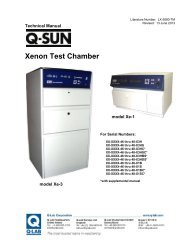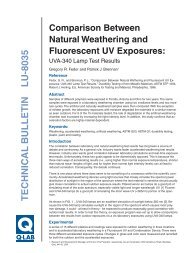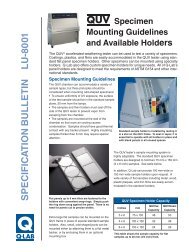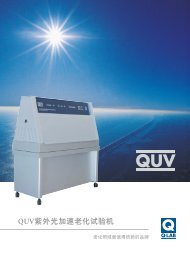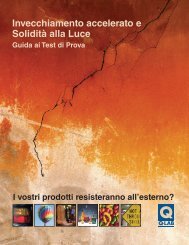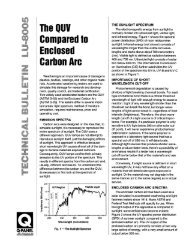TECHNIC AL B ULLETIN LX-5060 - Q-Lab
TECHNIC AL B ULLETIN LX-5060 - Q-Lab
TECHNIC AL B ULLETIN LX-5060 - Q-Lab
You also want an ePaper? Increase the reach of your titles
YUMPU automatically turns print PDFs into web optimized ePapers that Google loves.
Extended UV Filters<br />
Q-Sun Extended UV Filters<br />
allow significant excess UV<br />
below the cut-on of natural<br />
sunlight at the earth’s surface.<br />
Extended UV Filters<br />
are often used to produce<br />
faster degradation than<br />
Daylight Filters. They may<br />
also be used to reproduce<br />
extraterrestrial spectra for<br />
aerospace applications.<br />
Irradiance (W/m 2 /nm)<br />
3.0<br />
2.5<br />
2.0<br />
1.5<br />
1.0<br />
Extended UV - Quartz<br />
Extended UV - Q/B<br />
Direct Sunlight<br />
Extended UV Filters<br />
Extended UV - Q/B. This<br />
filter has a nominal cut-on<br />
at 275 nm. For many<br />
materials it will produce<br />
faster degradation than<br />
Daylight Filters. This filter<br />
may be required for certain<br />
automotive test methods<br />
including SAE J1960, SAE<br />
J1885, SAE J2412 and<br />
SAE J2527. It is described<br />
in ASTM G155.<br />
Extended UV - Quartz.<br />
Certain special applications<br />
require a spectrum<br />
with very aggressive, very<br />
short-wave UV to produce<br />
an extraterrestrial exposure<br />
condition. The quartz filter<br />
has a nominal cut-on at<br />
250 nm. This filter does not<br />
meet the requirements for<br />
an “Extended UV Filter” as<br />
defined in SAE or ASTM.<br />
Irradiance (W/m 2 /nm)<br />
0.5<br />
0.0<br />
260 300 340 380 420 460 500 540 580 620 660 700 740 780<br />
2.0<br />
1.8<br />
1.6<br />
1.4<br />
1.2<br />
1.0<br />
0.8<br />
0.6<br />
0.4<br />
0.2<br />
Wavelength (nm)<br />
For some materials, Extended UV Filters may produce faster<br />
degradation.<br />
Direct Sunlight<br />
Extended UV - Quartz<br />
Extended UV - Q/B<br />
Extended UV Filters - UV Region<br />
0.0<br />
260 270 280 290 300 310 320 330 340 350 360 370 380 390 400<br />
Wavelength (nm)<br />
Certain automotive test methods call for the spectrum produced by<br />
the Extended UV - Q/B filter.<br />
Technical Notes<br />
Sunlight Data. As used in this document, the terms "sunlight" and "direct sunlight" refer to sunlight as<br />
defined by using the input variables from ASTM G177 in version 2.9.2 of the SMARTS2 model and is<br />
approximately equivalent to noon, midsummer sunlight in the northern hemisphere. The term "sunlight<br />
through window glass" refers to a calculated value where direct sunlight data from CIE Table 4 is multiplied<br />
by the transmission of 1/8 inch glass of the type commonly used in North America.<br />
Q-Sun Data. The data shown in the graphs for Q-Sun filters was measured at the specimen plane in a<br />
Q-Sun Xenon Test Chamber. Data for the Daylight and Extended UV Filters was normalized to<br />
0.73 W/m 2 /nm @ 340 nm to provide a benchmark comparison with noon midsummer sunlight. Data for<br />
the Window Glass Filters was normalized to 1.20 W/m 2 /nm @ 420 nm to correspond with the calculated<br />
CIE/window glass data.<br />
2<br />
Cut-On. For purposes of this document, the “nominal cut-on wavelength” is defined as 0.2% of the<br />
irradiance at 420 nm, rounded to the nearest 5 nm.



